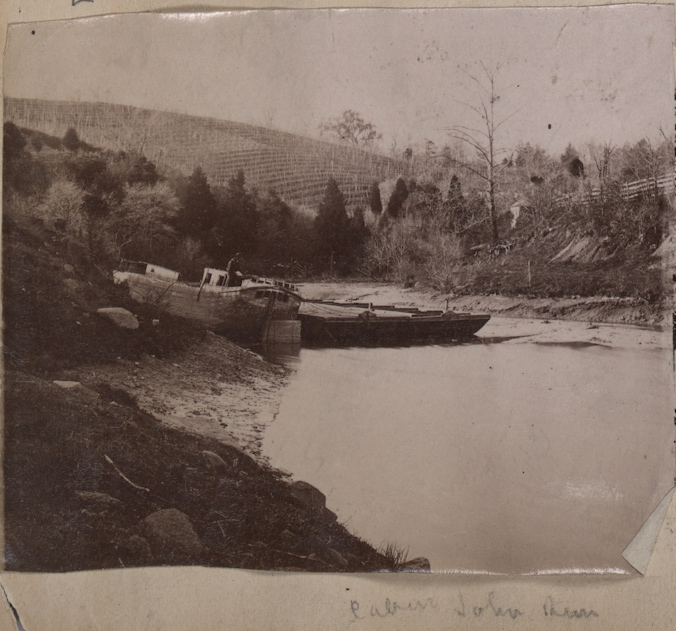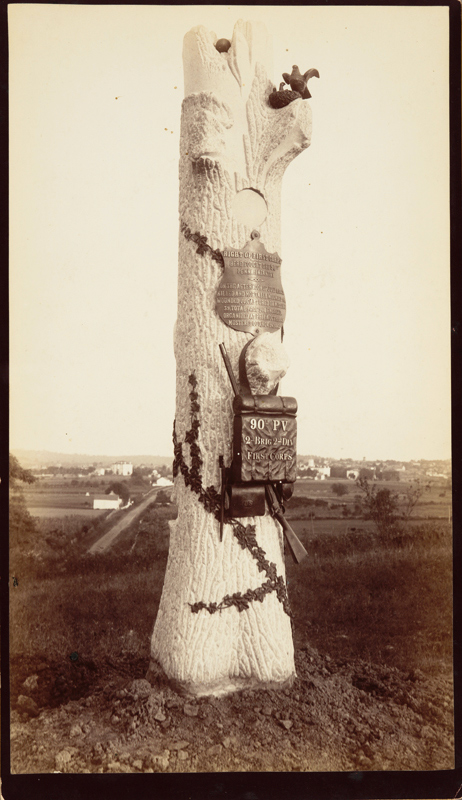
Cabin John Run, unidentified photographer, ca. 1865, James E. Taylor Collection (photCL 300), Scrapbook 1, Page 6, bottom left. Huntington Library, Art Collections, and Botanical Gardens.
The Huntington Digital Library just launched a new collection—the United States Civil War. It features more than 2,000 images from our impressive holdings of Civil War materials, many of which are being displayed in two new Huntington exhibitions: “A Just Cause: Voices of the American Civil War” and “A Strange and Fearful Interest: Death, Mourning, and Memory in the American Civil War.”
As intense and poignant as some of these images are from my vantage point as a digital librarian, my work on these materials has been filled with moments of remembrance of my own childhood visits to Civil War sites around my home in Maryland.
Many of these memories are not just of the iconic battlefield sites that are known around Washington, D.C.—Bull Run, Antietam, Gettysburg—but also the more prosaic, such as Cabin John Creek north of Washington, and a shattered tree stump on display at the Smithsonian. These memories flood back, sometimes immediately upon seeing a picture. Such was the case when I looked at the pages from the James E. Taylor Scrapbook and saw the image titled "Cabin John Run" (see above). I knew this place; as a kid I explored this creek, which flowed down to the C&O Canal. At the time the image was taken, the stream was dammed and used as a canal boat turn-around. And just above, beyond the turn in the creek, is the Union Arch Bridge, known to me as the Cabin John Bridge, part of the aqueduct that brings water to Washington, D.C.

Monument honoring the 90th Pennsylvania Infantry, 2nd Brigade, 2nd Division, 1st Corps, William H. Tipton (1850–1929), ca. 1885, Herbert William Singleton Collection Of Civil War Photographs (ca. 1861–90s), photCL 445 (215). Huntington Library, Art Collections, and Botanical Gardens.
Other times the memories came more slowly, drawn out by a series of images. Among the images now available online are a set that depict monuments at Gettysburg by photographer William H. Tipton. One of the monuments, honoring the 90th Pennsylvania Infantry, is in the form of a shattered tree trunk, with a cannon ball lodged in the heart of the tree at the top, the bark peeled away (at right). At first glance, I thought how unusual this was, and, as I moved onto the next monument, it stayed with me. A few weeks later, while working with the images depicting the battles around Atlanta, I saw the shattered trees cut down by musket and cannon fire. Then it clicked.
A memory came back to me—a tree trunk I had seen as a young boy at the Smithsonian. It seemed to me an impossibly large tree to have been cut down by a hail of gunfire, and yet there it stood, proof. I couldn't remember which battle had felled the tree, but that image brought me back to the monument at Gettysburg. Curious, I found the stump online here; it was cut down by gunfire, at Spotsylvania Courthouse, not Gettysburg. But clearly the image of shattered wood was evocative enough to use as a monument in the 1880s, and to stay with me after 40 years.
As an adult, I see the wider and deeper context attached to these images, and yet, many of the images remind me of autumn field trips and summer explorations with friends. It is a marvel to me how images from a terrible and bloody war fought 150 years ago can evoke such strong childhood memories.
You can search for images in The Huntington Digital Library. You can also explore Civil War photographs in the online component of the exhibition "A Strange and Fearful Interest: Death, Mounring, and Memory in the American Civil War."
Mario Einaudi is the Kemble Digital Projects Librarian at The Huntington.
